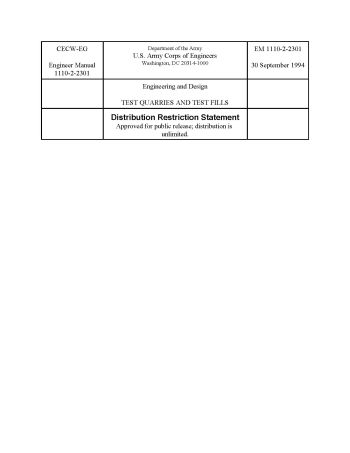Test Quarries and Test Fills (EM 1110-2-2301)
United States Army Corps of Engineers, 1994

An integral part of the development of large civil works projects is the establishment of sources of material for embankment or fill construction. Many water-retention and water-conveyance projects require large volumes of rock material. As a consequence, the selection of the project site and the selection of the types of project components frequently involve the type and availability of soil and rock materials. Test quarries are especially important where there are questions about the suitability and behavior of rock in required excavations for use in embankment rockfill zones, for slope protection or (less frequently) for concrete aggregate sources. Even experienced practitioners often cannot predict how rock obtained from an excavation or quarry will break down upon blasting and excavation or subsequently upon transport, placement, and compaction in a fill operation. The most frequent trouble has occurred when the quarried material either contained more fines or more oversized material or degraded more in transport, placement, and compaction than had been anticipated in the design. It has sometimes been necessary to make major design changes because rock behavior was contrary to that anticipated by the designers (EM 1110-2-1911). The use of test quarries and associated test fills has assisted in precluding such expensive surprises. In addition to providing the rock materials for test fills, test quarries have also provided the following information for project design:
a. Cut slope design constraints resulting from geologic structural details.
b. Blasting patterns and loading and resulting rock fragmentation.
c. Suitability of quarry-run rock.
d. Required rock processing methods.
On many projects, the results of quarry tests have also aided prospective bidders with a much better understanding of required excavation methods and rock drilling and blasting characteristics. The slope development aspects of the test quarry development (presplitting panels and production blast stand-off distances) and geologic maps of the test quarry slopes have aided in the design of required excavation slopes. Because of the time and cost associated with rock test quarries and test fills, it is imperative that they be carefully designed and conducted to yield good, useful data for the design.
Revision ID: 6825
Revision Date: 05/30/2023
